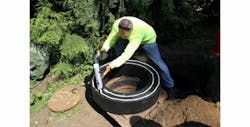The District of North Vancouver (DNV) in British Columbia faced a problem in the spring of 2015 when it had been tasked with the rehabilitation of existing manhole grade rings that were located off-road, in easements. The DNV had a list of approximately 50 manholes that required attention. Using a traditional concrete grade ring system made this project look daunting, as the manholes were spread out amongst remote locations.
Matt Pirrotta from Martech Inc. (representative for Cretex Specialty Products) met with DNV Utilities Supervisor Chris Alexander to discuss the advantages of using the Cretex Pro-Ring manhole and catch basin adjustment system over traditional methods. Alexander saw an opportunity for the product and quickly gave the go-ahead for a demonstration on one of the many manholes that required rehabilitation. The manhole is located in a residential area on Arborlynn Crescent in North Vancouver and tucked away in the backyard of a residence.
The Pro-Ring system consists of black expanded polypropylene (EPP) rings with a standard inner diameter of 24 in. and outer diameter of 36 in. EPP is an engineered plastic that is lightweight and has a very high strength-to-weight ratio. Pro-Ring can withstand repeated impacts without damage and resists water, most chemicals and temperature extremes from -31°F to 265°F. A traditional concrete grade ring would require up to four men to lift, while a 6-in.-thick Pro-Ring unit weighs 14 lb; one man can install the system in a few minutes.
The system consists of three types of rings: grade rings, finish rings and angle rings. Grade rings are used to raise the manhole to within an inch or two of the final elevation. A finish ring is applied in the final layer between the grade rings and the manhole frame. Angle rings are used when the surrounding surface is sloped.
Grade rings have one deep and one shallow groove on the underside and a single corresponding tongue on the upper side. The tongue and groove fit together so that rings align precisely when they are stacked. Finish rings have only the grooves on the underside and the upper side is smooth to enable maximum surface contact, and therefore a maximum seal, with the underside of the manhole frame. There is also a groove on the top inner diameter of the Finish ring designed to accept the Angle ring. The entire ring system is assembled and bonded together using a construction adhesive to create a watertight, testable system.
The Pro-Ring proved to be effective in this application, allowing crew members to easily handle the rings with little risk of injury. Aside from the obvious ergonomic benefit that the Pro-Ring provides, the DNV experienced the following positive results:
- less time spent on job site;
- less material required on job site; and
- smaller crew required on site.
The DNV was pleased with the results and decided to go with the Pro-Ring system instead of using traditional concrete. The key here was using a system that was ergonomically beneficial due to remote access of off-road manholes. In addition to this, they are now using a system that has a design life of 50 years, which will outlast traditional concrete. The DNV will complete the remainder of the project in spring and summer of 2016.







